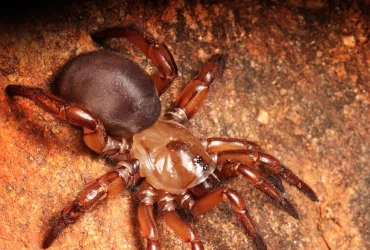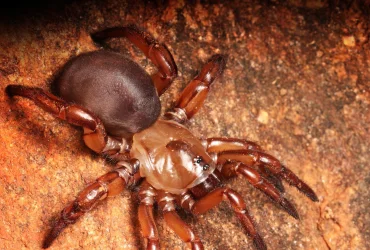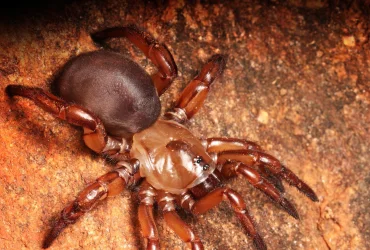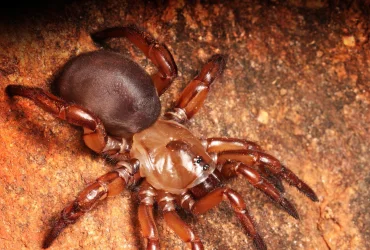Volume 9-14 (2020-26)
 v14i1.358
v14i1.358eISSN: 1800-427X (online)
DOI:10.47605/tapro.v14i1.358
Submitted date: 2 August 2024
Accepted date: 21 April 2025
Published date: 31 May 2025
Pp. 79–81.
Courtship and mating observation of olive ridley sea turtle (Lepidochelys olivacea)
K. Silambarasan*, A. Tiburtius, A.J. Chembian, C. Babu & P. Kumar
*Corresponding author. E-mail: silambuplankton@hotmail.com
Sea turtles spend most of their time below the water surface, making it difficult to observe their reproductive behaviour, particularly in open ocean habitats. Olive ridley sea turtles, Lepidochelys olivacea (Eschscholtz, 1829), and Kemp’s ridley sea turtle, Lepidochelys kempii (Garman, 1880), are the only species of the genus Lepidochelys, and tend to form large aggregations at nesting sites. Olive ridley sea turtles are unique in that some populations nest en mass, while others are solitary nesters. Irruptive nesting events are known as arribadas, where thousands of females come ashore to nest simultaneously. While other sea turtle species are also present in marine areas near nesting grounds, olive ridleys are distinctive in forming large aggregations during arribadas, while spending inter-nesting time in the open ocean. These nearshore areas provide rare opportunities for observation and facilitate research on their reproductive behaviour. However, studying their behaviour in offshore waters remains challenging, as mating events are typically brief and infrequent, making detailed studies of their mating rituals difficult.
Section Editor: Leandro Bugoni
DOI:10.47605/tapro.v14i1.358
Submitted date: 2 August 2024
Accepted date: 21 April 2025
Published date: 31 May 2025
Pp. 79–81.
Courtship and mating observation of olive ridley sea turtle (Lepidochelys olivacea)
K. Silambarasan*, A. Tiburtius, A.J. Chembian, C. Babu & P. Kumar
*Corresponding author. E-mail: silambuplankton@hotmail.com
Sea turtles spend most of their time below the water surface, making it difficult to observe their reproductive behaviour, particularly in open ocean habitats. Olive ridley sea turtles, Lepidochelys olivacea (Eschscholtz, 1829), and Kemp’s ridley sea turtle, Lepidochelys kempii (Garman, 1880), are the only species of the genus Lepidochelys, and tend to form large aggregations at nesting sites. Olive ridley sea turtles are unique in that some populations nest en mass, while others are solitary nesters. Irruptive nesting events are known as arribadas, where thousands of females come ashore to nest simultaneously. While other sea turtle species are also present in marine areas near nesting grounds, olive ridleys are distinctive in forming large aggregations during arribadas, while spending inter-nesting time in the open ocean. These nearshore areas provide rare opportunities for observation and facilitate research on their reproductive behaviour. However, studying their behaviour in offshore waters remains challenging, as mating events are typically brief and infrequent, making detailed studies of their mating rituals difficult.
Section Editor: Leandro Bugoni
 v14i1.357
v14i1.357eISSN: 1800-427X (online)
DOI:10.47605/tapro.v14i1.357
Submitted date: 24 December 2024
Accepted date: 21 April 2025
Published date: 31 May 2025
Pp. 77–78.
First record of shining bronze cuckoo (Chalcites lucidus) west of the Wallace Line
A.C. Herwanto, H. Susanto & R. Eprilurahman
*Corresponding author. E-mail: rurybiougm@ugm.ac.id
As part of bird monitoring activities in the working area of the Yogyakarta Natural Resources Conservation Agency (Balai Konservasi Sumber Daya Alam Yogyakarta), particularly in Gunungkidul Regency, officials unintentionally documented the presence of a Shining Bronze-cuckoo, Chalcites lucidus (Gmelin, 1788). We photographed a single individual on 21 June 2024 that we initially misidentified as a Horsfield's Bronze-cuckoo, Chalcites basalis
Section Editor: Bas van Balen
DOI:10.47605/tapro.v14i1.357
Submitted date: 24 December 2024
Accepted date: 21 April 2025
Published date: 31 May 2025
Pp. 77–78.
First record of shining bronze cuckoo (Chalcites lucidus) west of the Wallace Line
A.C. Herwanto, H. Susanto & R. Eprilurahman
*Corresponding author. E-mail: rurybiougm@ugm.ac.id
As part of bird monitoring activities in the working area of the Yogyakarta Natural Resources Conservation Agency (Balai Konservasi Sumber Daya Alam Yogyakarta), particularly in Gunungkidul Regency, officials unintentionally documented the presence of a Shining Bronze-cuckoo, Chalcites lucidus (Gmelin, 1788). We photographed a single individual on 21 June 2024 that we initially misidentified as a Horsfield's Bronze-cuckoo, Chalcites basalis
Section Editor: Bas van Balen
 v14i1.356
v14i1.356eISSN: 1800-427X (online)
DOI:10.47605/tapro.v14i1.356
Submitted date: 9 December 2024
Accepted date: 21 April 2025
Published date: 31 May 2025
Pp. 75–76.
Sparks beneath the sea? First record of a lined colour morph in the sea snakes
M.H. Patel & D.S. Parmar
*Corresponding author. E-mail: ophiophagus_hannah10@yahoo.com
A recent study by Parmar & Kaiser (2024) linked unusual morphs in Russell’s Vipers and Wolfsnakes to the spark/spark genotype mutation. We report a similar aberrant pattern for the first time in a sea snake observed in India (Bharuch District, Gujarat). During a marine reptile survey on January 26, 2019, near Aliabet, Bharuch District, in the Gulf of Khambhat (21.5958°N, 72.4408°E), fishermen caught 24 Annulated Sea Snakes (Hydrophis cyanocinctus) and one Little Filesnake (Acrochordus granulatus). One sea snake had an unusual pattern, differing from all other sea snakes. This individual measured 1030 mm in SVL with a tail length of 110 mm.
Section Editor: Ivan Ineich
DOI:10.47605/tapro.v14i1.356
Submitted date: 9 December 2024
Accepted date: 21 April 2025
Published date: 31 May 2025
Pp. 75–76.
Sparks beneath the sea? First record of a lined colour morph in the sea snakes
M.H. Patel & D.S. Parmar
*Corresponding author. E-mail: ophiophagus_hannah10@yahoo.com
A recent study by Parmar & Kaiser (2024) linked unusual morphs in Russell’s Vipers and Wolfsnakes to the spark/spark genotype mutation. We report a similar aberrant pattern for the first time in a sea snake observed in India (Bharuch District, Gujarat). During a marine reptile survey on January 26, 2019, near Aliabet, Bharuch District, in the Gulf of Khambhat (21.5958°N, 72.4408°E), fishermen caught 24 Annulated Sea Snakes (Hydrophis cyanocinctus) and one Little Filesnake (Acrochordus granulatus). One sea snake had an unusual pattern, differing from all other sea snakes. This individual measured 1030 mm in SVL with a tail length of 110 mm.
Section Editor: Ivan Ineich
 v14i1.355
v14i1.355eISSN: 1800-427X (online)
DOI:10.47605/tapro.v14i1.355
Submitted date: 16 December 2024
Accepted date: 21 February 2025
Published date: 31 May 2025
Pp. 71–74.
Pelung chicken research: A bibliometric analysis from 2010 to 2024
R.F. Yuneldi*, A.Y. Prawira, C.M. Airin, S. Sarmin & P. Astuti
*Corresponding author. E-mail: rizk056@brin.go.id
Pelung chicken, Gallus gallus gallus (Linnaeus, 1758), is an Indonesian endemic species of poultry from Cianjur, West Java. The characteristics of the Pelung chicken are that it has (1) a distinctive voice of long duration, (2) relatively fast growth, and a large physical shape, (3) good meat quality, which can be seen from the improvement in muscle mass and strength, and (4) growth performance in line with high testosterone levels. This species has been defined under the 2918/kpts OT.140/6/2011 decree issued by the Ministry of Agriculture as a native Indonesian free-range chicken that is to be protected and conserved, as well as a national asset. The chicken is reportedly threatened due to decreased population size.
Section Editor: José M. Saiz-Alvarez
DOI:10.47605/tapro.v14i1.355
Submitted date: 16 December 2024
Accepted date: 21 February 2025
Published date: 31 May 2025
Pp. 71–74.
Pelung chicken research: A bibliometric analysis from 2010 to 2024
R.F. Yuneldi*, A.Y. Prawira, C.M. Airin, S. Sarmin & P. Astuti
*Corresponding author. E-mail: rizk056@brin.go.id
Pelung chicken, Gallus gallus gallus (Linnaeus, 1758), is an Indonesian endemic species of poultry from Cianjur, West Java. The characteristics of the Pelung chicken are that it has (1) a distinctive voice of long duration, (2) relatively fast growth, and a large physical shape, (3) good meat quality, which can be seen from the improvement in muscle mass and strength, and (4) growth performance in line with high testosterone levels. This species has been defined under the 2918/kpts OT.140/6/2011 decree issued by the Ministry of Agriculture as a native Indonesian free-range chicken that is to be protected and conserved, as well as a national asset. The chicken is reportedly threatened due to decreased population size.
Section Editor: José M. Saiz-Alvarez
 v14i1.354
v14i1.354eISSN: 1800-427X (online)
DOI:10.47605/tapro.v14i1.354
Submitted date: 7 October 2024
Accepted date: 21 April 2025
Published date: 31 May 2025
Pp. 69–70.
Unusual nest construction by cinereous tit (Parus cinereus) in an artificial nest box
M. Bilaskar*
*Corresponding author. E-mail: rishi08sep@gmail.com
The cinereous tit, Parus cinereus Vieillot, 1818 is the descendant subspecies of the great tit (Parus major), which it was included with until it was recognised as a separate subspecies. The nesting behaviour of the cinereous tit is characterized by its preference for cavity nesting. These birds typically choose tree hollows, crevices in rocks, or even man-made structures such as walls and pipes for nesting. During the breeding season, which generally occurs from March to July, the female cinereous tit plays a dominant role in nest construction. In urban settings, they may use synthetic materials such as pieces of cloth or plastic. The typical clutch size ranges from 4 to 8 eggs, with incubation lasting about 12 to 14 days. Both parents are involved in feeding the chicks, with the fledging period extending for approximately 16 to 20 days.
Section Editor: Xu Luo
DOI:10.47605/tapro.v14i1.354
Submitted date: 7 October 2024
Accepted date: 21 April 2025
Published date: 31 May 2025
Pp. 69–70.
Unusual nest construction by cinereous tit (Parus cinereus) in an artificial nest box
M. Bilaskar*
*Corresponding author. E-mail: rishi08sep@gmail.com
The cinereous tit, Parus cinereus Vieillot, 1818 is the descendant subspecies of the great tit (Parus major), which it was included with until it was recognised as a separate subspecies. The nesting behaviour of the cinereous tit is characterized by its preference for cavity nesting. These birds typically choose tree hollows, crevices in rocks, or even man-made structures such as walls and pipes for nesting. During the breeding season, which generally occurs from March to July, the female cinereous tit plays a dominant role in nest construction. In urban settings, they may use synthetic materials such as pieces of cloth or plastic. The typical clutch size ranges from 4 to 8 eggs, with incubation lasting about 12 to 14 days. Both parents are involved in feeding the chicks, with the fledging period extending for approximately 16 to 20 days.
Section Editor: Xu Luo
Hubungi Kami
The ultimate aim of the journal is to provide an effective medium for communication of the latest and best scientific information.
Copyright © 2020 Taprobanica. All Rights Reserved
Jasa Pembuatan Website by IKT




